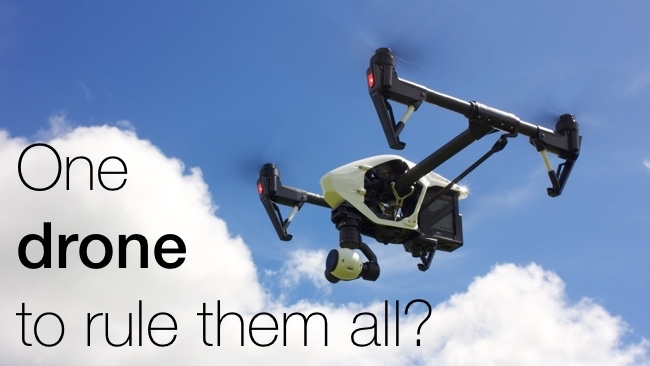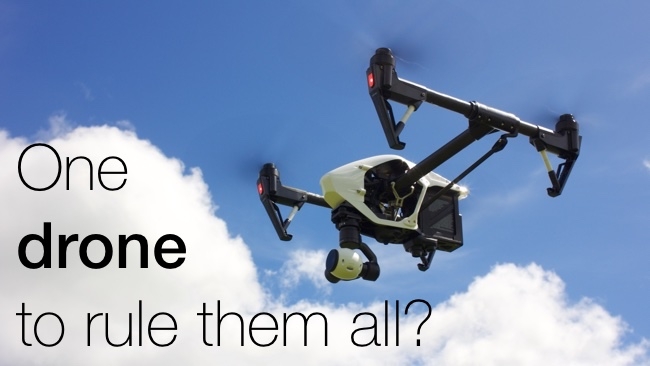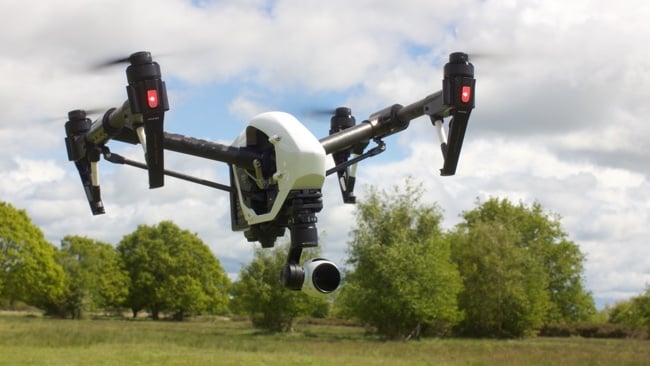
 Flight of fancy: the DJI Inspire 1
Flight of fancy: the DJI Inspire 1
In the second of our major two-part review of the DJI Inspire 1 UAV, Simon Wyndham takes to the skies.
(You can read the first part of Simon's review here.)
Can you fly this bird, Murphy?
I couldn’t resist getting a Blue Thunder quote into this review somehow! I’m not exactly Roy Schneider, however it is a big question. On paper the Inspire 1 should be easier to fly than my toy quadcopter. After all it does have the ability to auto hover. Never-the-less my toy copter cost around £30 while the Inspire was £2300! Trepidation filled my mind when I first took the new beast outside ready to fly.
Each time you arrive at a new location it is recommended that you calibrate the compass. This is fairly straightforward and involves selecting the calibration procedure from within the Pilot app and then spinning the craft around both its horizontal and vertical axis. This does have to be done with care. The compass is extremely sensitive to interference. Even having your mobile phone in your pocket or holding the transmitter next to it can mess things up. Even magnetic rock can be an issue, which may cause problems if you are on the mountains in, say, the Lake District.
The good news is that once you have gone through this procedure successfully and you have attached the rotors you are finally, yes finally, ready to fly!
Firing up the Pilot app and transmitter first followed by the Inspire itself, the system then runs through various checks and connects with the GPS signal. The app then announces that it is safe to fly, or not depending on whether a signal was found or not. When you use the craft for the very first time it defaults to beginner mode, which limits the height, distance, and speed that you can fly, as well as locking you into GPS flight mode. I kept this setting on for the first flight.
I took a deep breath, checked the area was clear, and hit the auto take off button. Wow! If you love science fiction movies you will go totally gaga when the Inspire 1 takes off for the very first time! The app announces in loud speech that the home point has been logged and that auto take off is about to occur. The motors fire up and the Inspire lifts up into the air. The app announces that the landing gear is raising and you watch in awe as the Inspire 1 transforms itself into flight mode. It looks simply awesome, and in fact I'm surprised nobody is charging just to watch this process!
I have seen videos of the Inspire flying many a time, but nothing really prepares you for how fantastic it is in reality. Once it has taken off in GPS mode it literally just holds itself solid and stationary in the air.
Compared to the toy quadcopters that I had been practising with previously the Inspire 1 is a whole new beast. It is pretty incredible just how easy it is to fly. Letting go of the stick after performing a move the Inspire simply stops and holds itself in a stationary hover again. Even in ATTI mode, which disables the auto hover the aircraft is simple to fly because it maintains altitude. Unlike a fully manual quadcopter you do not have to compensate with the throttle when flying forward in order to maintain height.
A glance down at your tablet shows the height, speed, horizontal distance from the operator, signal strength and all manner of other information. It is a bit daunting at first so I do highly recommend that you familiarise yourself with the settings in simulator mode first.
Another aspect that is extremely impressive is just how clear and high resolution the live video feed from the Inspire is. It is so good that the Inspire will be useful for all sorts of live inspections and surveys, not just recording pretty pictures. Using the HDMI output from the transmitter you could connect a recording device to record an emergency backup of the footage, although it will be limited to 720p resolution.
On my initial flight day the wind was quite gusty, and yet the Inspire coped incredibly well, holding completely steady in GPS mode. This is one area where the Inspire excels compared to the Phantom. Some have claimed that the Inspire has held pretty well even in 30mph winds. It has a lot of reserve power. Although using it in such conditions uses up the battery power much more quickly than a calmer day.
Controls were responsive but predictable at the same time. There is a very solid feeling of control with the Inspire 1. The very distinctive shape of the Inspire also helps with visual orientation during flight. Many multirotor craft look very similar in any orientation, but the shape of the Inspire 1 makes this easier. To assist even more there are coloured lights at the front and back that further help to distinguish which direction the craft is facing.
There is a lot of power at your disposal. Once beginner mode has been turned off the Inspire has an impressive turn of speed and some very sharp acceleration. It would be easy to get carried away, but you need to remain aware of your surroundings at all times. Could a complete novice fly one? Yes, resoundingly. Any person regardless of experience could fly the Inspire in some way. But it will still take practice to so I would still recommend starting out with a much smaller and less expensive multirotor to learn the fundamentals.
The ultimate selfie

I decided that it would be a good time to have a play around with the camera. The transmitter has a control for the tilt of the camera, you can also lock the camera in place so that it stays pointing in the same direction no matter what the orientation of the aircraft is.
By holding your finger down on the live view you can drag the camera view around, as well as set the exposure by clicking on the area of interest. The camera has two general modes, semi manual and manual. In semi manual mode you can select a shutter speed and the camera will auto expose using gain/ISO. In full manual mode you can set the shutter speed and ISO. White balance can also be locked from the picture style menu.
Annoyingly the camera reverts to automatic mode when you close the manual control menu. This is a bit frustrating because the dialogue box obscures the live view area.
While the Inspire 1 has its amazingly cool retractable rotor assembly, care still needs to be exercised with the angle of the camera. Under hard acceleration with the camera tilted up a bit can still introduce rotors into the shot.
A ND filter is supplied with the package, but it isn't really strong enough for bright sunny days. In order to set the shutter speed and the ISO of choice you will most certainly need a set of ND filters. Unfortunately while one company has produced a set they are nigh on impossible to get hold of. There might be an opening here for the likes of Tiffen given the increasing popularity of the Inspire 1.
Where am I?
In live view mode a map is shown as a realtime updated thumbnail in the bottom corner of the screen. By pressing on this the main view swaps over to present the map full screen with the live view now as a thumbnail.
Unfortunately if you have no internet access the map cannot update. Luckily for us DJI has accounted for this and if you know where you are flying the Pilot app allows you to cache the map before you head out. If you forget to do this it doesn't affect GPS or the ability of the craft to return to its takeoff home point.
How good is the footage?
Examining the footage closely reveals that it does suffer from the default sharpness settings being too high. This can have an adverse effect on the compression system. In 4K mode the bitrate runs up to 60Mbit/s which isn't a hugely high amount. However as we have pointed out on RedShark before numbers don't tell you everything.
On complex detail there were some compression artefacts when the sharpness was at its default setting. Artefacts are reduced when the sharpness is dialled down, but they can still be present. This I would imagine is down to the compressor that is being used. Not all compressors are alike, and it is a shame about this because it is a weak point in an otherwise very strong system.
In a general edit these would be difficult to see, but it could be a deal breaker for some. However you must consider that to make the next step up to a system that can carry a higher quality camera will cost you an order of magnitude more. It will be interesting to know whether there is anything that can be achieved with a firmware update, but I would imagine that such things are handled by hardware.
Conclusion
Who is the Inspire 1 for? It isn't a toy, that's for certain. Personally I think that the Inspire 1 is clearly a piece of kit designed for the professional or "Prosumer" if there is still such a thing. I know some multirotor operators who guffaw at the suggestion because it is a ready to fly craft and cannot carry a camera such as the BMPCC and therefore is not professional.
This would be a very narrow minded view to take because there are many tiers of production. The cost of building a system that can carry a GH4 or BMPCC is comparatively large. All businesses have to start somewhere! There are plenty of producers who will be over the moon at the results that are capable of being produced from the Inspire 1.
If you are intending to use a multirotor in a professional capacity should you go for the Inspire or the Phantom 3 Professional?
One of the principal differences between the Inspire 1 and the Phantom 3 Professional is that the camera on the Inspire 1 can be spun 360 degrees without seeing any part of the craft. The camera on the Phantom on the other hand is limited to being able to tilt up and down with any panning being performed by the aircraft itself. The Phantom is also much more susceptible to having rotor blades appear in shot leading many operators to fly them backwards to minimise this risk.
In addition the camera on the Inspire 1 can be upgraded, which should hopefully ensure that your investment lasts. The Inspire 1 is also much more powerful and can cope with a wider range of wind conditions than the Phantom.
However, the Inspire 1 is twice the price of the Phantom 3, although both are incredible value for money. Consider that with the Inspire you are getting a flight control system that is apparently more advanced than DJIs own A2 system, the Rolls Royce of flight controllers, and you are also getting a full Lightbridge system for the realtime video feeds. Both these systems together would cost almost the same as the Inspire 1 as a whole.
For me it comes down to versatility. For longevity in professional use the Inspire is a good investment. With future firmwares offering even more capabilities including waypoint control and new cameras this system should go from strength to strength.
You do have to be committed though. If you wish to dabble then I would highly recommend getting an inexpensive £30 multirotor to see if flying suits you.
If you are serious about entering this brave new world of aerial video and photography then the Inspire would mark a very good starting point. The Inspire 1 is an absolute step change in what affordable technology can do, and it will only get more advanced and more capable in the coming years.
I am seriously impressed.
Addendum
In the review I mentioned that some Inspire 1 props have been found to be unbalanced and need to be balanced by the user. I have been informed that the new quick release props that are supplied on the new Inspire 1s are now dynamically balanced at the factory, so this shouldn’t be an issue any more. - SW
Tags: Production


Comments